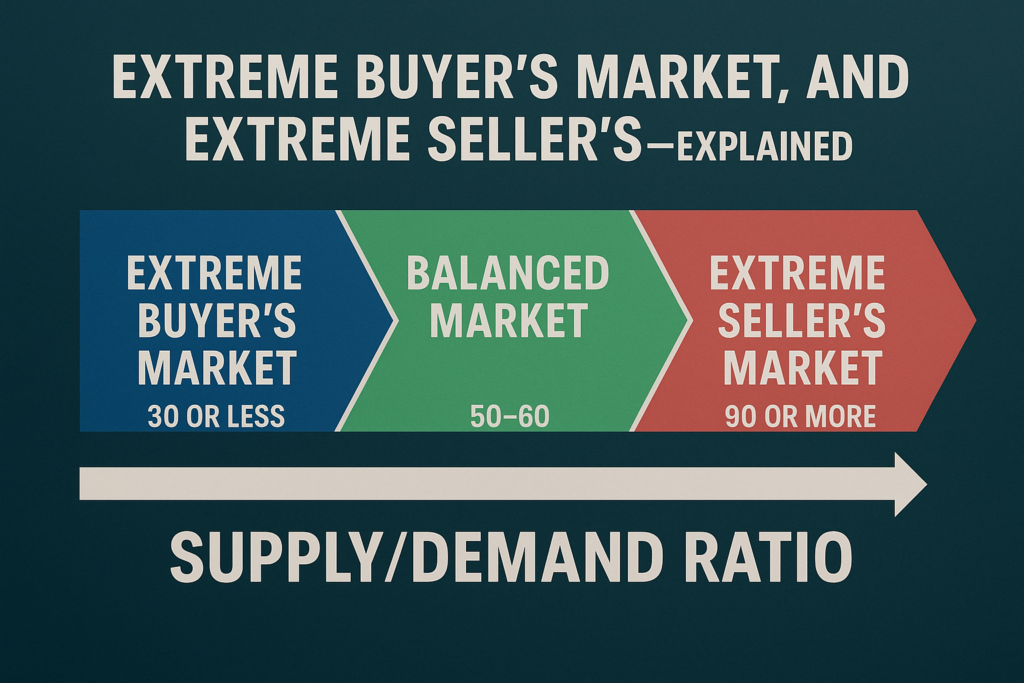Extreme Buyer’s Market, Balanced Market, and Extreme Seller’s Market—Explained
You may have heard terms like Buyer’s Market, Extreme Buyer’s Market, Balanced Market, Seller’s Market, or Extreme Seller’s Market—but what do they actually mean?
Each of these phrases refers to a numerical value called the Supply/Demand Ratio (formerly called the Contract Ratio). This ratio compares the number of homes available for sale (supply) to the number of homes under contract (demand). In simple terms, it measures how many buyers are actively purchasing homes relative to how many homes are listed.
Here’s how the ratio is typically interpreted:
- 30 or less: Extreme Buyer’s Market
- 50–60: Balanced Market
- 90 or more: Extreme Seller’s Market

Over the past few years, we’ve seen this ratio climb to over 200. That was one reason Metro Phoenix home prices increased approximately 70% between 2019 and 2022. During that time, the supply of homes was extremely limited—largely due to homeowners choosing not to sell during the COVID-19 pandemic. Meanwhile, demand remained strong as people relocated to Arizona for reasons like remote work flexibility, lower cost of living, favorable tax conditions, and job growth.
To illustrate how quickly the market can shift:
As of February 10, 2023, we were compiling our January Housing Market Update. Just one year earlier, the ratio stood at 171%, placing us firmly in an Extreme Seller’s Market. By the end of 2022, the ratio dropped to 32%, indicating an Extreme Buyer’s Market. Then, in January 2023, it rebounded to 51%, bringing us into a Balanced Market.
I’ve noticed that these terms can cause confusion—or even frustration—for some people, so let me explain how this applies to real-world transactions.
In my book Selling Your Home in Today’s Market, I outline the three key negotiation stages where buyers and sellers interact:
- Step 7 – Negotiating the Contract Price
- Step 9 – The Home Inspection
- Step 10 – The Appraisal
–>In a Balanced Market, neither party holds a significant advantage. Both the buyer and seller typically need to compromise to close the deal.
–>In a Buyer’s Market or Extreme Buyer’s Market, the buyer has more leverage. Sellers may need to:
- Reduce their asking price
- Pay part of the buyer’s closing costs
- Make repairs or offer concessions after the home inspection
- Lower the price if the appraisal comes in low
–>In a Seller’s Market or Extreme Seller’s Market, the seller is in control. Buyers may have to:
- Offer above asking price
- Agree to non-refundable earnest money*
- Waive inspection contingencies*
- Waive or cover appraisal shortfalls*
*Important Note:
During the last Extreme Seller’s Market, I served as the Designated Broker reviewing contracts. I saw many buyer’s agents make critical mistakes by writing offers that improperly waived their clients’ rights. If you’re a buyer in a competitive market, ask your agent to use the Additional Clause Addendum for proper protection.
The most commonly used sections during the last extreme market were:
- Line 26 – Non-Refundable Earnest Money
- Line 32 – Waiver of Appraisal
- Line 37 – Appraisal Shortfall
I hope this explanation helps clarify what these market terms really mean. If you have any questions or comments, feel free to reach out.
📅 Book a call with Michael Hankerson
🔗 The Supply/Demand Ratio is just one of fifteen key stats we track each month. To learn more about all the metrics that influence pricing, negotiation, and timing, read our full article: 15 Key Stats That Reveal Where the Phoenix Housing Market Is Headed.
#LinkBrokerages

2 Responses